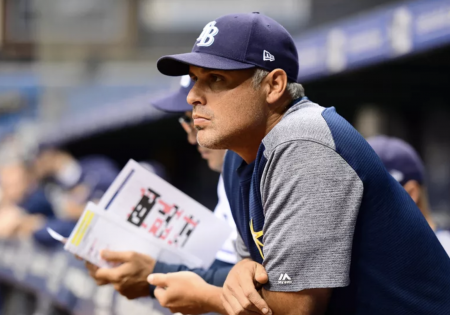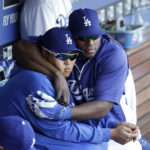Postseason Sleeper: How About the Tampa Bay Rays?
 This century has seen more wild card teams, as well as more small-market teams, win championships and succeed in the playoffs due to the use of performance analytics, which have changed the way teams manage player development, situational baseball and roles on a team. Stars will be stars, but all championship-caliber teams have breakthroughs, whether it’s through player evolution or metrics management. For 2019, I believe the MLB postseason sleeper with the best combination of both is the AL Wild Card Tampa Bay Rays, a creative, versatile and deep well-oiled machine.
This century has seen more wild card teams, as well as more small-market teams, win championships and succeed in the playoffs due to the use of performance analytics, which have changed the way teams manage player development, situational baseball and roles on a team. Stars will be stars, but all championship-caliber teams have breakthroughs, whether it’s through player evolution or metrics management. For 2019, I believe the MLB postseason sleeper with the best combination of both is the AL Wild Card Tampa Bay Rays, a creative, versatile and deep well-oiled machine.
Creative Management
Kevin Cash has been one of the best and most creative managers in baseball since taking over for Joe Maddon in 2015. While some in-game managing now is also through the front office (the Rays have a great one), Cash has done a nice job with young players and new players throughout many roster moves. Conceptually, he is very creative, too, similar to Maddon.
Between lineup combinations, player switches throughout the game and using many different pitchers as openers, his style of management is creative and often unpredictable. When it comes to micromanagement in the postseason, where players are replaced and moved around quicker than ever, that kind of system should work effectively, especially when both their pitchers and position players are versatile.
Perfect Modern Bullpen
Their bullpen is not like the Yankees, Brewers or Braves with the flashy names, but they’re still effective, and they’re perfect for different situations. They’ve had different guys close throughout the year, from Jose Alvarado to Diego Castillo to Emilio Pagan.
They’ve had different guys, such as Ryan Yarbrough, Jalen Beeks, Ryne Stanek and Yonny Chirinos, have the versatility to start, be a specialist, be a setup guy, and pitch multiple innings at unconventional times. That is important in a day and age where relievers come in constantly to play the best matchups, and to come in earlier than usual to keep inherited runners from scoring.
The days of the Royals, the late ’00s Phillies, and the early ’10s Giants with the traditional bullpen tandems are fading away. A new era of using starters out of the bullpen and relievers in different situations through analytics is taking over. As a result, there isn’t a lot of pure closers anymore. And the ones still around don’t have long shelf lives of being dominant, with some exceptions (Aroldis Chapman, Kenley Jansen, Craig Kimbrel until this year). Also, when these top closers are overused or used in non-save situations in modern postseason play, they haven’t been as effective. Take Jansen in the 2017 World Series and Kimbrel in several games last postseason as primary examples.
The Rays don’t have this issue because their players have the mentality and situational familiarity of many different roles. In an analytical and micromanaging era, having the bullpen versatility is just as important as having the bullpen talent. The Rays have that, and then some, with starting pitchers Charlie Morton and Tyler Glasnow who have experience pitching out of the bullpen as well—Morton did it in dominant fashion in multiple Game Sevens when the Astros won the 2017 World Series.
Position Player Versatility
The postseason sleeper Rays have it all when it comes to lineup versatility. They have more than conventional utility players. These are guys who can defend at different positions well, including Brandon Lowe, Joey Wendle, Guillermo Heredia and Daniel Robertson. Players like Matt Duffy and Willy Adames also can defend multiple infield positions. As a result, the Rays are Top 10 in a lot of defensive statistics, including defensive runs saved and defensive efficiency ratio.
When it comes to different spots in the lineup, with the exception of Tommy Pham hitting second 121 times, no player has hit in an individual spot any more than 53 times. This kind of thinking keeps opposing managers and pitchers guessing when it comes to their approach to a game.
Not to mention, their lineup is deep, too, which you need in today’s game—especially in postseason play when breakthrough players make a difference. Would the Red Sox have won the World Series without guys like Steve Pearce, Brock Holt and Jackie Bradley hitting as well as they did in the postseason? Probably not. Do the Cubs win the 2016 World Series if guys like David Ross and Ben Zobrist don’t hit amidst struggles of their stars? Probably not.
Even dynamic offenses like the 2015-2016 Blue Jays and the 2010-13 Reds didn’t do well in the playoffs because their lineups were more top-heavy and dropped off significantly, talent-wise, after the fifth spot in the batting order. With the exception of the San Francisco Giants, no team has won with that kind of structure recently.
The Rays have plenty of depth with players like Travis D’Arnaud, Ji-Man Choi and Avisail Garcia, to go along with their core of talented youngsters. Mix in the fact that, besides Joey Wendle and a small sample size of Christian Arroyo, nobody has a batting average below .260, meaning there are no easy outs.
And while they have no .300 hitters, the Rays have a core of guys with on-base percentages of .330 or higher, showing they are patient at the plate. The Rays’ hitters are good at doing the little things, too, such as quality of at-bats and good base running, which can make a difference when tie-breaking similar statistical seasons. So, while Rays hitters don’t have flashy names, it doesn’t mean they have a bad lineup. They have the balance and versatility to compete as the postseason sleeper.
























